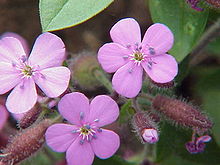Saponaria
| Saponaria | |
|---|---|

| |
| Saponaria ocymoides | |
| Scientific classification | |
| Kingdom: | Plantae |
| Clade: | Tracheophytes |
| Clade: | Angiosperms |
| Clade: | Eudicots |
| Order: | Caryophyllales |
| Family: | Caryophyllaceae |
| Genus: | Saponaria L. (1753) |
| Species | |
|
30-40, see text | |
| Synonyms[1] | |
| |
Saponaria is a
herbaceous perennials and annuals, some with woody bases. The flowers are abundant, five-petalled and usually in shades of pink[3] or white.[2] The genus is closely related to the genus Silene, being distinguished from these by having only two (not three or five) styles in the flower.[3] It is also related to Gypsophila, but its calyx is cylindrical rather than bell-shaped.[4]
The most familiar species might be
emulsifier in Turkish delight confections, but this is a case of double confusion. The roots of plants in genus Gypsophila are used to make the Turkish confection helva and Saponaria species are not used.[7]
Saponaria species are eaten by the larvae of some butterflies and moths, including the Lychnis and Coleophora saponariella, which is exclusive to the genus.
Diversity
There are thirty[4][8] to forty[2][9][10] species in the genus.
Plants of the World Online accepts 39 species:[1]
- Saponaria aenesia Heldr.
- Saponaria bargyliana Gomb.
- Saponaria bellidifolia Sm.
- Saponaria biovulata (Stapf) Barkoudah
- Saponaria bodeana Boiss.
- Saponaria caespitosa DC.
- Saponaria calabrica Guss.
- Saponaria cerastoides Fisch. ex C.A.Mey.
- Saponaria cypria Boiss.
- Saponaria dalmasi H.Boissieu
- Saponaria emineana Gemici & Kit Tan
- Saponaria glutinosa M.Bieb.
- Saponaria griffithiana Boiss.
- Saponaria gypsacea Vved.
- Saponaria halophila Hedge & Hub.-Mor.
- Saponaria iranica Dashti, Assadi & Sharifnia
- Saponaria jagelii Phitos & Greuter
- Saponaria karapinarensis Vural & Adıgüzel
- Saponaria kotschyi Boiss.
- Saponaria lutea L.
- Saponaria mesogitana Boiss.
- Saponaria ocymoides L.
- Saponaria officinalis L.
- Saponaria orientalis L.
- Saponaria pachyphylla Rech.f.
- Saponaria pamphylica Boiss. & Heldr.
- Saponaria picta Boiss.
- Saponaria pinetorum Hedge
- Saponaria prostrata Willd.
- Saponaria pumila Janch.
- Saponaria pumilio Boiss.
- Saponaria sewerzowii Regel & Schmalh.
- Saponaria sicula Raf.
- Saponaria stenopetala Rech.f.
- Saponaria subrosularis Rech.f.
- Saponaria suffruticosa Nábělek
- Saponaria syriaca Boiss.
- Saponaria tadzhikistanica (Botsch.) V.A.Shultz
- Saponaria tridentata Boiss.
References
- ^ a b "Saponaria L." Plants of the World Online. Royal Botanic Gardens, Kew. Retrieved 9 March 2024.
- ^ a b c d e f Thieret, John W.; Rabeler, Richard K. (2005). "Saponaria". In Flora of North America Editorial Committee (ed.). Flora of North America North of Mexico (FNA). Vol. 5. New York and Oxford: Oxford University Press – via eFloras.org, Missouri Botanical Garden, St. Louis, MO & Harvard University Herbaria, Cambridge, MA.
- ^ ISBN 978-1405332965.
- ^ a b Ghazanfar, Shahina A.; Nasir, Yasin J. "Saponaria". Flora of Pakistan – via eFloras.org, Missouri Botanical Garden, St. Louis, MO & Harvard University Herbaria, Cambridge, MA.
- ISBN 9781604691962.
- ISBN 978-0892815388.
- ISBN 978-1-84885-898-5. Retrieved 9 March 2024.
- ^ Lu, Dequan; Lidén, Magnus; Oxelman, Bengt. "Saponaria". Flora of China. Vol. 6 – via eFloras.org, Missouri Botanical Garden, St. Louis, MO & Harvard University Herbaria, Cambridge, MA.
- .
- ^ Hartman, Ronald L.; Rabeler, Richard K. (2012). "Saponaria". In Jepson Flora Project (ed.). Jepson eFlora. The Jepson Herbarium, University of California, Berkeley.
External links
- Saponaria. ITIS.
